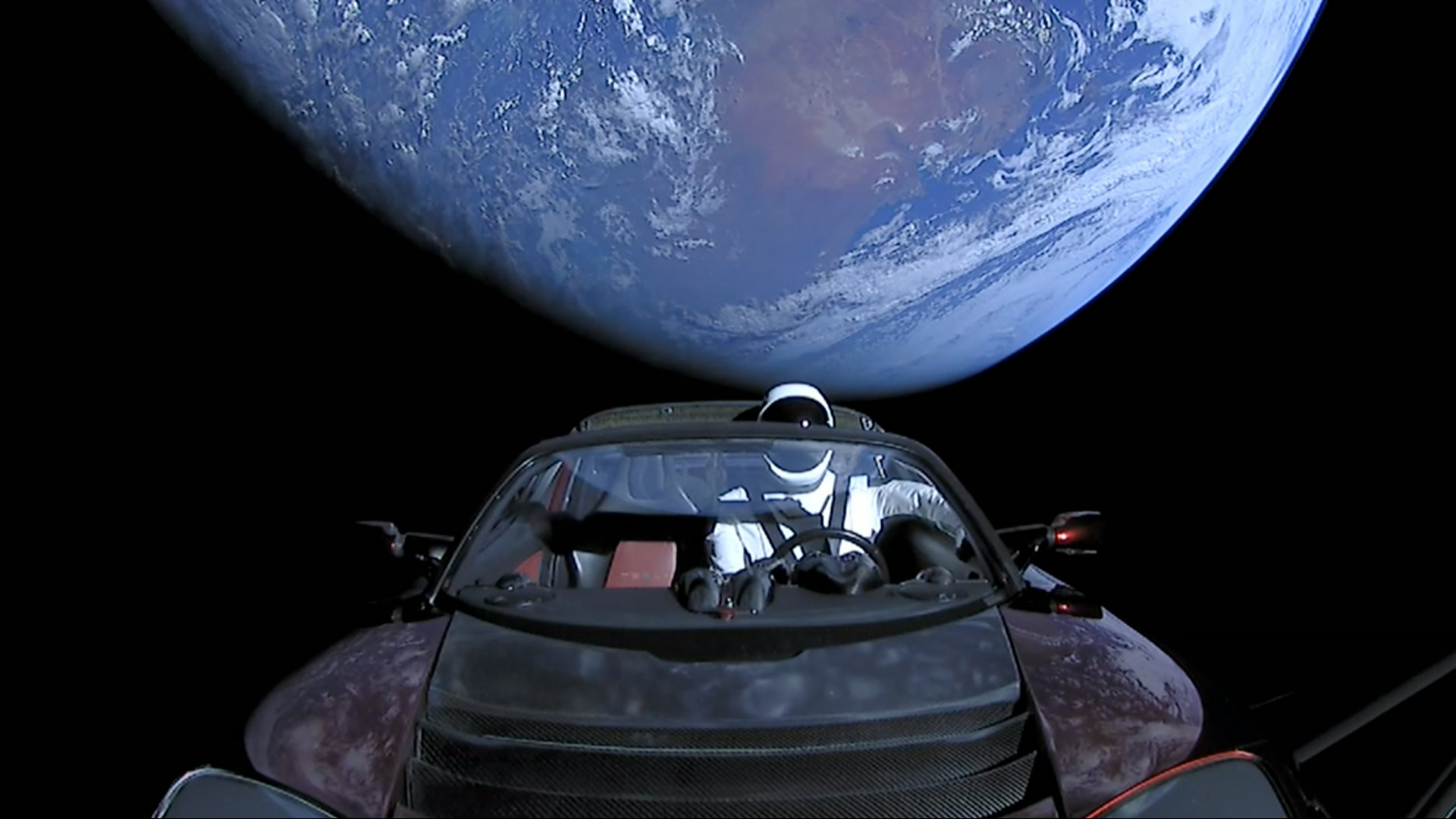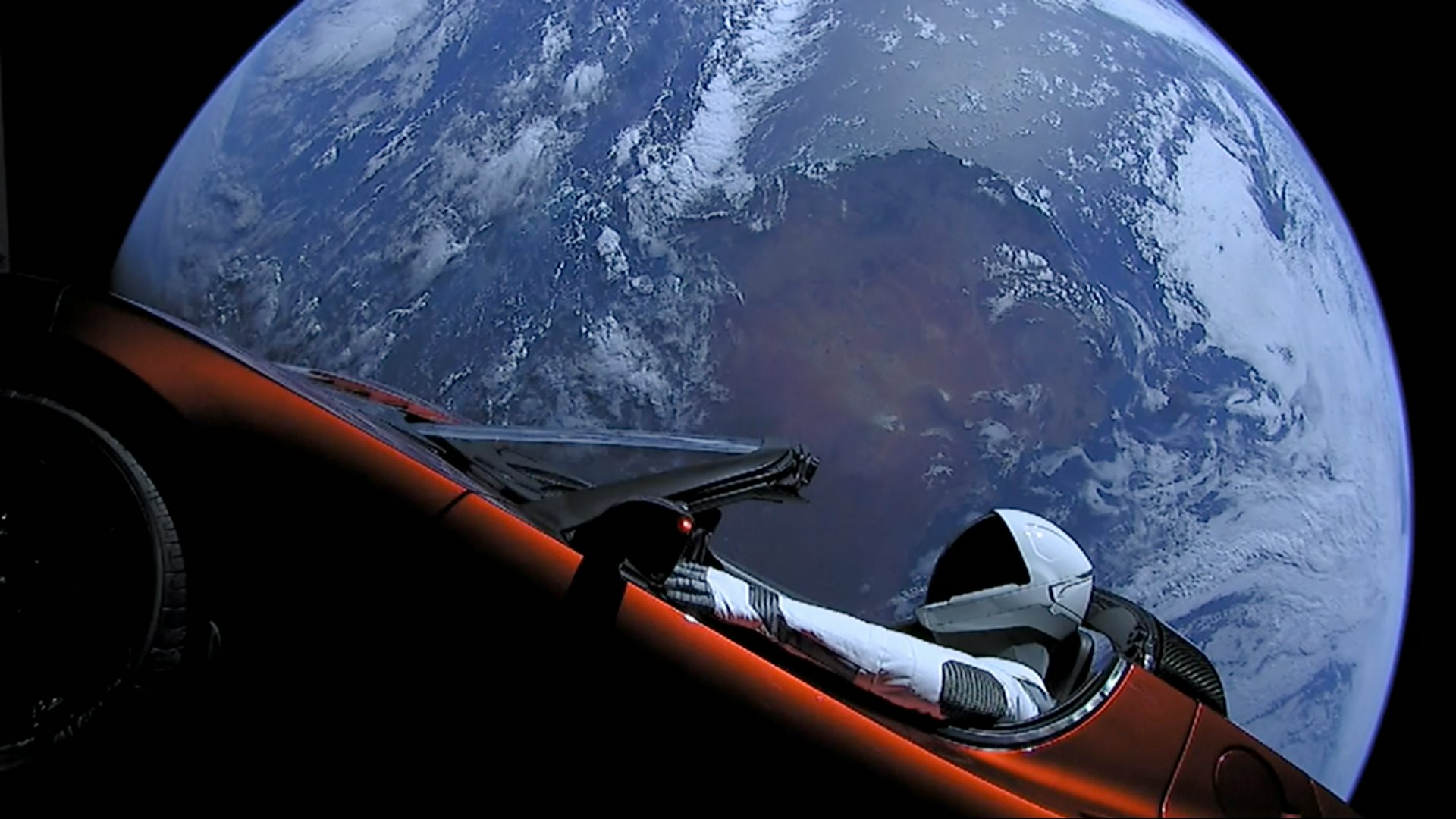
For the first test flight of the SpaceX Falcon Heavy rocket on February 6, 2018, SpaceX — and Tesla — CEO Elon Musk decided to launch the “silliest” test payload imaginable: his own car. The midnight cherry-hued Tesla roadster reached around 26,000 miles per hour, sufficient speed to escape Earth’s gravity and outpace any ground speed record imaginable.
The reactions from the public, scientists, and space law professionals at the time of the launch varied from unalloyed enthusiasm to derision of the silly “stunt,” to worried concerns that the car could strike Earth or otherwise become a hazardous piece of space debris in the future.
Now, five years later, the roadster is still out there and doesn’t appear to be on a course to cause problems in the short term. Still attached to the Falcon Heavy rocket's upper stage (the component that navigates through space), Musk’s car is about 200,000 miles from Earth on an orbit around the Sun that sees it periodically cross the orbits of Earth and Mars.
“It's actually crossing the orbit of Mars around the Sun right now,” Harvard Astrophysicist Jonathan McDowell tells Inverse in an email, “but Mars is completely on the other side of the Sun, and in fact, Earth is much closer to Mars than either is to the Tesla!”
But whether the roadster launch has made an impact on space law and commercial space culture may be another story altogether. After all, just how silly do you want space stuff to be when everything involved travels faster than a bullet inside a deadly radiation-filled vacuum?
The SpaceX Roadster Recap
SpaceX began development on the heavy-lift rocket that would become the Falcon Heavy in 2011 with an eye toward an initial test flight in 2013, but the program proved more difficult than expected.
A heavy-lift rocket must carry at least 44,092 pounds into low Earth orbit, and Musk wanted to push around 140,000 pounds into low Earth orbit, with reusable booster sections too. To achieve that level of performance, SpaceX had to figure out how to connect three of its reusable Falcon 9 booster sections together along with an additional upper stage.
When the time came for the first uncrewed test flight of the new rocket on February 6, 2018, Musk needed a dummy payload to model how the Falcon Heavy would handle delivering mass into space, and his 2,900-pound car fit the bill. But he wouldn’t just launch the car without layering in sci-fi and cultural symbolism. A space-suited mannikin dubbed “Starman” would sit in the driver’s seat while David Bowie’s “Space Oddity” played on the radio. The glove box contained a copy of Douglas Adams’s cosmic comic novel, “The Hitchhiker’s Guide to the Galaxy,” and the car also carried a towel and a sign reading “Don’t Panic,” features of the novel.
The rocket lifted off at 3:45 pm EST from Launch Complex 39A at Kennedy Space Center, the same launch pad used for the very first NASA Saturn V rocket launch in 1967. Cameras on the car carried a live stream of the Starman and the roadster in orbit around the Earth until the car’s battery died, and the Falcon Heavy upper stage and the roadster both sped away from Earth on a heliocentric orbit.
Astronomer and science blogger Phil Plait wrote that he wasn’t sure whether Musk was joking when the roadster launch was announced. Jason Davis, blogging for The Planetary Society, collected an array of reactions to the launch from an artist friend who found the notion that the roadster was art silly because it “just seems like such a waste,” reactions from people on Twitter who felt the launch was the ultimate “masculine mid-life crisis.”

Catching the SpaceX Roadster today
As of today, the roadster is around 203 million miles from Earth, according to the website www.whereisroadster.com, which has been tracking the car and providing stats, significant and silly, about its travel since 2018. The roadster has exceeded its 36,000-mile warranty by 69,989 times, for instance, having traveled more than 4 billion miles since reaching space. If the car’s battery still had power, and the song “Space Oddity” had been looping on the radio the entire five years, it would have played nearly half a million times.
The Legacy of Elon’s Roadster
A paper published in the journal Aerospace in 2018 and charmingly titled “The random walk of cars and their collision probabilities with planets” pegged the odds of the roadster colliding with the earth in the next 15 million years at about 22 percent. No collision is imminent, though the roadster will pass within the distance of the Moon from Earth in the next 100 years.
So with the possibility of the roadster becoming hazardous space debris, at least on any salient timescale, how does the roadster launch come off five years later? McDowell, who has not hesitated to correct Musk on matters such as the precise orbit of the roadster and tracks SpaceX satellites in his spare time, isn’t particularly bothered.
“Elon Musk deserves attention for what he is doing to his employees, the night sky, democracy, or his newest toy Twitter. But continuing a discussion about whether his car is orbiting Mars or the Sun is really missing the point.”
“They needed to do a test launch of the rocket. Bolting the Tesla on the front as a hood ornament demonstrates the lift capacity,” McDowell says. “I think it was a good advertising stunt for the car company and for the rocket company, on balance.”
Laurą Forczyk, the founder of the space industry analysis firm Astralytical, thinks that the roadster launch event had some benefits for the commercial space industry, or, at least, for SpaceX.
“I loved that it inspired people outside of the space community,” she tells Inverse in an email. “SpaceX became a household name in part because of stunts like that. And it was absolutely only something a private company and not a government agency could do.”
But Christopher Johnson, a space lawyer with the nonprofit Secure World Foundation, worries that the roadster launch is part of a trend of bold actions in space that erode the legal norms set up by the Outer Space Treaty of 1967, which makes nations responsible for the actions of private companies in space and set rules against harmful interference with other nation’s space operations and against contamination of the space environment.
“What I think of as the 5th anniversary of the Elon roadster stunt is the same reaction I had to Swarm Technologies launching without frequency permission coordination,” Johnson tells Inverse.
Swarm Technologies had been denied a radio frequency license necessary to operate its microsatellites by the FCC, which told the company the satellites, as designed, would be too difficult to track. They launched four microsatellites from a site in India on January 12, 2018, anyway, and were assessed a $900,000 fine by the FCC. It was an example, according to Johnson, of a clash between traditional space safety culture, international law, and “The commercial philosophy, and especially Silicon Valley philosophy, of go fast, break things,” he says, “and that it is better to ask forgiveness than permission.”
SpaceX bought Swarm Technologies in 2021.
Another example of clashing cultures and more serious, potentially detrimental space “stunts” involved the April 2019 crash landing of the Israeli lunar lander Beresheet. It carried a payload from the Arch Mission Foundation that included a sample of tardigrades, extremely hardy microscopic organisms sometimes called “water bears,” that could potentially live on the Moon. The foundation had not disclosed to the FAA that the tardigrades were part of the payload before launch, according to Johnson.
Steven Mirmina, a professor at Georgetown University Law School, wrote a blog post in 2018 musing about just this kind of moral hazard when it comes to “stunts” in space. SpaceX arguably didn’t cause the contamination of space as did the Arch Mission Foundation or flaunt national and international law like Swarm Technologies, “But, what about the next billionaire?” Mirmina wrote. “What happens when the next hypothetical cryptocurrency billionaire decides to launch his 23-story “Hello Kitty” rocket into orbit?”
Looking back, Mirmina tells Inverse, some of his fears have already come to pass.
“The list of stupid things people are doing in space has only increased with time,” he writes in an email. “Some immediate ones that come to mind include disco balls in space, human ashes (and dog ashes) in space; instant "meteor showers" on demand by launching BBs into space (what could possibly be bad about that, right)?”
To be fair to SpaceX, the examples Mirmina cites — the “Humanity Star” launched by company Rocket Lab in 2018, the companies Elysium Space and Celestis launching human or pet remains into space, and another company, Astro Live Experiences, aiming to create meteor showers — all have roots going back before Musk put his car on a rocket.
So maybe the roadster launch was an exception that helps highlight a troublesome trend. And maybe it's a distraction best left in the rearview mirror.
Hanno Rein, a professor of astronomy and astrophysics at the University of Toronto at Scarborough and lead author of the 2018 paper that calculated the odds of the roadster striking Earth thinks that five years on, no one cares about Musk’s car. If people are going to write about the tech billionaire, Rein says, they should focus on the labor practices at his company, how the SpaceX Starlink satellites are creating light pollution, and Musk’s recent turn as the Chief Twit at Twitter.
“Elon Musk deserves attention for what he is doing to his employees, the night sky, democracy, or his newest toy Twitter. But continuing a discussion about whether his car is orbiting Mars or the Sun is really missing the point,” Rein tells Inverse in an email. “You can quote me on that.”







